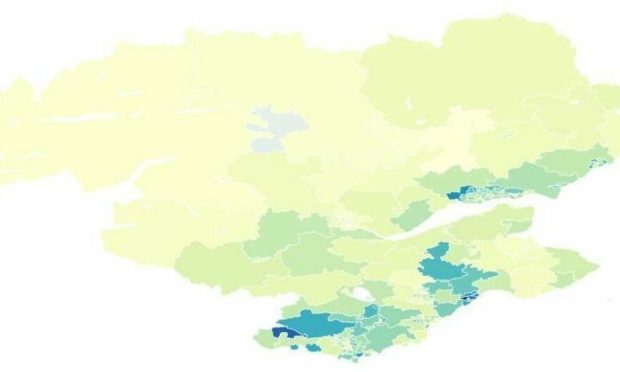The number of positive cases of Covid-19 has been rising again with some record breaking numbers following Scotland’s move beyond level zero.
But how has the rise in cases impacted Tayside and Fife?
Our interactive charts show the spread of Covid-19 and the change in circumstances in neighbourhoods across the area from the start of June to the end of August.
How have cases changed across Scotland?
Restrictions were eased further on August 9, seeing the reopening of some settings that have been closed since the start of the pandemic, and the further relaxing of other rules.
Since this date, there has been a sharp rise in the number of reported positive cases, peaking at 7,113 on August 29. This was partly attributed to a delay in cases being reported due to high testing numbers, with some cases coming from more than 48 hours prior to the day.
Some of the daily case numbers recorded since the move to beyond level zero are the highest seen throughout the entirety of the pandemic so far.
Cases in Tayside and Fife
At the start of June, cases remained fairly low across the board, with many areas reporting no case rate due to having between zero and two cases in a seven-day period, however cases are increasing again.
Our interactive map below shows each neighbourhood in Tayside and Fife and how case rates have changed in the past two months, where the darker a region is, the higher case rate it has.
A greyed out neighbourhood indicates that there was between zero and two cases and as a result any data has been suppressed.
Since June, Methil Methilhill has recorded the four highest case rates per 100,000 population in a seven day period.
The highest rate was 2050.01 on August 31, followed by 2027.48 per 100,000 population on August 30, 1802.21 per 100,000 population on August 29 and 1779.68 on August 28.
The highest rate in Dundee was recorded in Whitfield on July 1 with a case rate per 100,000 population of 1738.28.
The top 20 case rates recorded across Tayside and Fife since the start of June have all been in Dundee or Fife, with Whitfield in Dundee accounting for six of the top 20 highest rates and Methil Methilhill accounting for five of them.
Have hospitalisations been affected?
As more people continue to be vaccinated, the number of people in hospital with confirmed Covid-19 has not reached the same levels as seen in previous waves of the virus.
Select the health board you are interested in from the chart below.
In NHS Tayside, there was a peak of cases recently in the middle of July, with the highest number of people in hospital recently recorded as 65 on July 13. This is significantly lower than in January, where hospitalisations peaked at 189 on January 16.
The number of patients in ICU has also remained low, although there was seven people in ICU in Tayside on July 22.
In NHS Fife, hospitalisations were at their highest in recent months at the end of July, with 45 patients in hospital with confirmed Covid-19 on July 23 and July 30.
They were steadily decreasing, but have seen a rise again at the end of August, with 22 people in hospital on August 31.
There have been no patients in ICU recorded in NHS Fife recently.
Deaths in Scotland
Like hospitalisations, despite the rise in cases, the number of deaths from coronavirus has not been as high as seen in previous high waves of the virus.
A number of days in the past few months saw no deaths, while the highest number of deaths registered recently was 22, on July 22.
In comparison, the highest number of deaths seen in one day in the last wave of coronavirus was 92, on January 27.
To find out more about Covid-19 in Scotland see our tracker.
For more information on the vaccination rollout in Scotland, click here.
